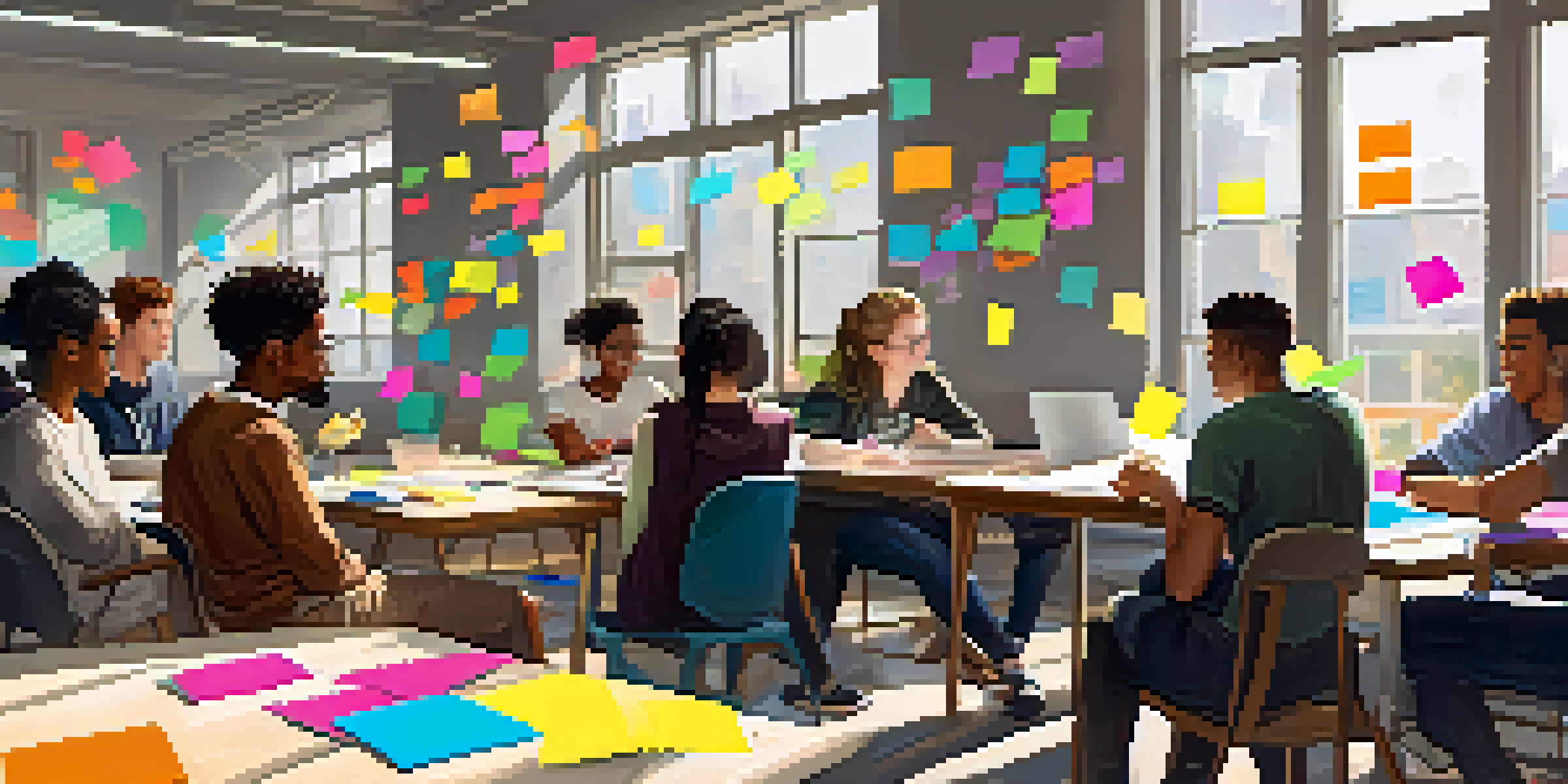The Role of Peer Feedback in Digital Learning Experiences

What is Peer Feedback in Digital Learning?
Peer feedback is the practice of students giving and receiving constructive criticism on each other's work. In a digital learning environment, this can take many forms, such as comments on assignments, video reviews, or even collaborative projects. By engaging in this process, students not only improve their understanding of the material but also develop essential skills like critical thinking and communication.
Feedback is the breakfast of champions.
For instance, imagine a group of students working on a presentation. Instead of just waiting for their teacher's feedback, they share their drafts with one another. This interaction allows them to see different perspectives, which can spark innovative ideas and enhance their overall project quality.
Ultimately, peer feedback fosters a sense of community and collaboration, making the digital learning experience more enriching and engaging for all involved.
Benefits of Peer Feedback for Students
One of the significant advantages of peer feedback is that it encourages active learning. When students assess each other's work, they engage in a deeper analysis of the subject matter, which helps reinforce their knowledge. This active participation can lead to a better grasp of concepts compared to passive learning methods like listening to lectures.

Additionally, peer feedback promotes accountability among students. Knowing that their peers will review their work can motivate them to put in extra effort and produce higher-quality submissions. This shared responsibility can create a more supportive learning environment where students feel invested in each other's success.
Peer Feedback Enhances Learning
Engaging in peer feedback helps students deepen their understanding of material and develop critical thinking skills.
Moreover, receiving feedback from peers can sometimes feel less intimidating than from instructors. This can lead to more honest discussions and a willingness to grow, as students feel more comfortable sharing their thoughts and experiences.
Challenges of Implementing Peer Feedback
While peer feedback offers many benefits, it also comes with challenges. One of the most common issues is that students may lack the skills to provide constructive criticism. Without proper guidance, they may offer vague or overly harsh feedback, which can be discouraging rather than helpful.
The greatest gift is not being afraid to question.
To address this, educators can provide structured guidelines or rubrics to help students understand what constitutes effective feedback. For instance, teaching them to use the 'sandwich method'—starting with a positive comment, followed by constructive criticism, and ending with another positive note—can make feedback more palatable.
Additionally, some students may feel uncomfortable critiquing their peers, especially if they are friends or classmates. Creating a culture of trust and respect within the classroom can help alleviate these concerns, ensuring that feedback is viewed as an opportunity for growth rather than a personal attack.
The Role of Technology in Facilitating Feedback
Technology plays a crucial role in enhancing the peer feedback process in digital learning. Online platforms can provide students with tools to give real-time feedback, such as comment sections, forums, or collaborative documents. These features not only streamline the feedback process but also encourage more frequent interactions among students.
For example, platforms like Google Docs allow multiple users to edit and comment on a document simultaneously. This real-time collaboration fosters a dynamic exchange of ideas, making the feedback process more engaging and interactive.
Trust is Key for Effective Feedback
A culture of trust and respect encourages honest and constructive peer feedback among students.
Moreover, technology can help track feedback history, allowing students to reflect on their development over time. This record can serve as a powerful motivator, showing them how their skills have evolved through peer interactions.
Creating a Culture of Trust for Effective Feedback
Establishing a culture of trust is vital for effective peer feedback. When students feel safe and respected in their learning environment, they are more likely to provide and accept constructive criticism. Educators can cultivate this atmosphere by modeling positive feedback behaviors and encouraging open dialogue among students.
Activities such as icebreakers or team-building exercises can help break down barriers and foster connections. The more comfortable students are with one another, the more likely they are to engage in honest and supportive feedback.
Additionally, teachers can emphasize the importance of growth mindset, reinforcing the idea that feedback is a valuable tool for improvement rather than a judgment of ability. This shift in perspective can empower students to embrace feedback as a crucial part of their learning journey.
How to Train Students in Giving Feedback
Training students to give effective feedback is essential for maximizing its benefits. Educators can offer workshops or mini-lessons focused on feedback techniques, helping students understand the importance of clarity, specificity, and respect in their critiques. This foundational knowledge equips them to provide more impactful feedback to their peers.
Role-playing scenarios can also be beneficial. By practicing feedback in a controlled setting, students can learn how to navigate difficult conversations and develop their communication skills in a safe environment. This practice can build their confidence when it comes time to offer real feedback.
Technology Streamlines Feedback Process
Digital platforms facilitate real-time interactions, making the peer feedback process more engaging and effective.
Incorporating peer feedback training into the curriculum can lead to more productive interactions. When students feel prepared and capable, they are more likely to engage in meaningful discussions that foster growth and improvement.
Future Trends in Peer Feedback for Digital Learning
As digital learning continues to evolve, so too will the methods and tools for peer feedback. Emerging technologies like artificial intelligence and machine learning may soon enable personalized feedback systems that adapt to individual student needs. This innovation could enhance the feedback process, making it even more relevant and effective.
Additionally, gamification—integrating game-like elements into learning—might play a significant role in encouraging peer feedback. By creating a system of rewards for constructive feedback, educators can motivate students to participate actively in this process.

Finally, as online learning environments become more prevalent, the emphasis on building community will likely grow. Peer feedback will remain a cornerstone of collaborative learning, fostering connections and enhancing the overall educational experience for students.